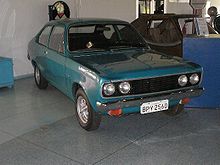Brazilian Miracle
This article includes a list of generalreferences,butit lacks sufficient correspondinginline citations.(February 2016) |

TheBrazilian Miracle(Portuguese:milagre econômico brasileiro) was a period of exceptional economic growth in Brazil during the rule of theBrazilian military dictatorship,achieved via a heterodox and developmentalist model. During this time the average annual GDP growth was close to 10%. The greatest economic growth was reached during the tenure of PresidentEmílio Garrastazu Médicifrom 1969 to 1973.

James Petrasargues the short-lived economic miracle in Brazil was based on:
a) violent illegitimate seizure of political power by the military;
b) the institutionalization of violence through an extensive and intensive system of military-police controls throughout civil society;
c) the systematic use of terror to contain popular discontent, to disarticulate mass organizations and to destroy guerrilla resistance;
d) the elaboration of the National Security ideology to justify the State's "permanent state of war" against autonomous class or nationalist movements.[1]
Perception of the so-calledGolden Ageof Brazilian development was strengthened in 1970, when Brazil, for the third time, won theFIFA World Cup,and the official adoption of the slogan "Brasil, ame-o ou deixe-o"(" Brazil, love it or leave it ") by the Brazilian military government.
According to Elio Gaspari, in his bookA Ditadura Escancarada:"The Brazilian Miracle and theYears of Leadhappened simultaneously. Both were real, coexisting and denying each other. More than thirty years later, they continue to do so. For every person who thinks one existed, there is a person who doesn't believe (or doesn't like to admit) the other one happened. "[2]
Background[edit]

During the presidency ofJoão Goulart,the economy was nearing a crisis, and the annualinflationrate reached 100%. After the1964 coup d'état,the Brazilian military was more concerned with political control and left economic policy to a group of entrusted technocrats, led byDelfim Netto.[3]
Brazil became an urban society, with 67% of its people living in cities. That was caused by a population shift from the poorer countryside to the booming cities, withSão Paulogrowing faster than the others.[4]
Brazil relied on a heterodox, developmentalist model.[5]Its expansion in this period relied on low wages, rapidly rising exports, and foreign capital inflows.[5]
The growth during this period is associated with the government minister who oversaw the strategy,Antônio Delfim Netto.[5]Delfim Netto originated the phrase "cake theory" in reference to this model: the cake had to grow before it could be distributed.[5]Although the "cake" in Delfim Netto's metaphor did grow, it was highly unequally distributed.[5]
Successes[edit]
The government became directly involved in the economy, as it invested heavily in new highways, bridges, and railroads. Steel mills, petrochemical factories, hydroelectric power plants, and nuclear reactors were built by the large state-owned companiesEletrobrasandPetrobras.To reduce the dependency on imported oil,ethanol industrywas heavily promoted.
By 1980, 57% of Brazil's exports were industrial goods, compared with 20% in 1968.[6]
In this period, the annual GDP growth rate jumped from 9.8% per year in 1968 to 14% in 1973 and inflation rose from 19.46% in 1968 to 34.55% in 1974.[7]
Problems[edit]
To fuel its economic growth, Brazil needed more and more imported oil. The early years of the Brazilian Miracle hadsustainable growthand borrowing. However, the1973 oil crisismade the military government increasingly borrow from international lenders, and the debt became unmanageable. By the end of the decade, Brazil had the largest debt in the world: about US$92 billion.[8]
Economic growth definitely ended with the1979 energy crisis,which led to years ofrecessionandhyperinflation.
References[edit]
- ^Petras, James (1987)."The Anatomy of State Terror: Chile, El Salvador and Brazil".Science & Society.51(3): 314–338.ISSN0036-8237.JSTOR40402812.
- ^Gaspari, Elio.A Ditadura Escancarada.São Paulo: Cia. da Letras, 2002; ISBN 8535902996
- ^Handler, Bruce (1975-06-08)."Plying High in Rio".The New York Times.ISSN0362-4331.Retrieved2019-04-18.
- ^1968–1980: the 'Brazilian Miracle'
- ^abcdeWeber, Isabella(2021).How China escaped shock therapy: the market reform debate.Abingdon, Oxon:Routledge.p. 244.ISBN978-0-429-49012-5.OCLC1228187814.
- ^Pattnayak, Satya R. (1996).Globalization, Urbanization, and the State: Selected Studies on Contemporary Latin America.University Press of America.ISBN9780761803539.
- ^Economia Brasileira Contemporânea.Giambiagi, Fabio,, Castro, Lavinia Barros de,, Hermann, Jennifer,, Villela, André ([3. ed.] ed.). Rio de Janeiro, Brasil. 2017-04-13.ISBN9788535238556.OCLC1049153964.
{{cite book}}:CS1 maint: location missing publisher (link) CS1 maint: others (link) - ^Kilborn, Peter T.; Times, Special to The New York (1983-11-26)."Brazil's Economic 'Miracle' and Its Collapse".The New York Times.ISSN0362-4331.Retrieved2019-04-17.
